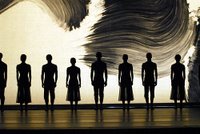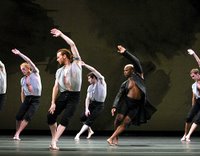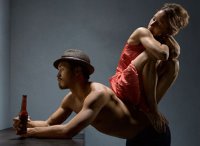I used to wonder what exactly critics meant when they'd say that a piece of work was "wretched." I imagined scruffy dancers clad in rags, shuffling along to dirges. I have since come to what admittedly might be a completely different-- and perhaps only particular to me-- definition of the term. It is a work that makes you feel wretched. Hide your face in your hands, I want to weep wretched.
. And I think I also ought to mitigate what probably sounds like critical hyperbole, by saying that this was a personal reaction, based on what I had hoped to see, and what I then didn't get to see. Other people in the audience obviously had a far more positive experience that evening, if the applause and shouts at the final curtain call were anything to go by.
But I couldn't join in. Like someone looking for a piece of lost childhood only to find it's been paved over and made into a strip mall, I felt, honestly, a little heartsick.
As a born New Yorker, I'm one of those hordes of people who are terribly sentimental about the Joffrey Ballet. One of my running jokes is that whenever a dancer is mentioned in our house, I always add, "Oh, and of course she was with Joffrey."
There's a reason for that -- at one time
everyone was with the Joffrey, because Joffrey wasn't just at the epicenter of American ballet, it
was American ballet. Fresh, quirky, technical, but with soul, Joffrey had an idiosyncratic reputation, but kept everyone coming back because we all wanted to know what they'd do next. The rep included Ballets Russes revivals and works by fresh faces in American choreography. They did high energy populist works like Gerald Arpino's
Trinity, and high drama in John Cranko's
Romeo & Juliet. They did biting satire in Kurt Jooss'
Green Table and broad comedy in Ashton's
La fille mal gardee. It was a company that gloriously defied categorization.
So when I realized what ballets the company was planning to perform here in Berkeley, I had to wonder why on earth, with the vasty Joffrey repertoire available to them, would the company choose to bring
Billboards, of all things, on this tour--its first in to the Bay Area in many years.
I have nothing against Laura Dean, and certainly Prince's music is not to be sneezed at. But from the larger than life vinyl banner that proclaims "BILLBOARDS" across the body of a sexily lounging female dancer (with a small, but legible "Gannett" logo at the hem) there was an atmosphere of slick and yet desperately dated commercialism that summed up their Zellerbach appearance.
As far back as 1996, critic Clive Barnes warned of the danger of relying on commercially viable, but artistically void
Billboards as a staple of the Joffrey repertoire. In an editorial for
Dance Magazine, he said presciently,
The Joffrey over the years has built up a fabulous repertoire of modern classics--from, most notably Ashton, Massine, and Jooss -- and a fascinating Ballets Russes collection, as well as many decent creations, particularly from Arpino himself. It was a company with a plan and a purpose, a national company, distinct from both New York City Ballet and American Ballet Theatre, and a company that overseas could represent American classic ballet at its best. If to survive it has to give up the very thing that made its survival important, one wonders what has been gained.
(Dance Magazine, November, 1996)
So what's it doing on the rep of Joffrey's tour, a tour celebrating the company's 50th anniversary? And why has the company brought two of the most tired items from their 70s and 80s years? Even if these pieces might have been fresh back then, has the Joffrey acquired no newer, more interesting, more relevant repertoire since then? I catch myself thinking this is decidedly
not the Joffrey that I grew up idolizing.
It's not to say that the company lacks talent in the dancers. To the contrary, the company has a number of engaging dancers in Stacy Joy Keller, Heather Aagard, Willy Shives, but there's only so much they can do in a situation where the company direction is obviously lacking.

I must admit though, that I was somewhat horrified to see that
Pas de Deesses, once a staple of the Joffrey repertoire, looked so close to parody. What has happened to coaching? I had to go back to a former Joffrey ballet master to ask what the atmosphere of the ballet was supposed to be. Was I remembering it through a child's rose-colored glasses? Where was the warmth, the airy Romantic graces with the hint of gracious rivalry?
Devised by Robert Joffrey as a tribute to the beautiful Romantic era in the vein of
Pas de Quatre, the dancers are meant to look as if they'd just stepped from a lithograph.
The dancers-- Kathleen Thielhelm as Taglioni, Victoria Jaiani as Grahn, Keller as Cerrito and Fabrice Calmels as Arthur St. Leon -- are lovely to look at, but seemed to have little idea as to what was interesting about the interaction between these 19th century personalities or differentiating from, even contrasting with, the style of contemporary ballet. In fact, this performance was decidedly 21st century--developpes carried the legs up to the nose and around the body 180 degrees to back of the head, eliciting gasps from the audience members behind us. All I could think was how horrified Grahn would have been at the idea of showing off her nether-regions to the audience in such an unladylike, contortionist fashion.
Unfortunately, the Tharp
Deuce Coupe which followed on the program, has also not kept pace over the years, though I would argue that the fault lies in the choreography and not the coaching. Set to a
Sessions Presents the Best of amalgam of Beach Boys hits, it looks even more dated than
Pas de Deesses. None of its nineteen sections stays long enough to really grate on you, but the whole exercise has forced jollity, and a self-conscious coyness to it.
Against a graffiti tagged trio of walls, the men --in red spandex and Hawaiian shirts, think Freddie Mercury raiding Don Ho's closet -- slink and sidle across the stage in hip-swivelling glissades across the stage. The women-- dressed no better in Scott Barrie's unflattering short orangey-tan dresses-- bop interspersed among them, ponytails swinging.
Tharp provides no narrative stream, unless you count the subplot of Heather Aagard as the ballerina performing uncomfortable ballet class combinations in pointe shoes in the middle of the stage. The work is admittedly early Tharp, but like many choreographers, she appears here to have no idea what to do with a woman in pointe shoes except to make her stand on tippy toe or spin fast. When not performing these feats of balance, which Aagard manages admirably, she has to sidle and swivel uncomfortably next to people having a lot more fun in jazz shoes. This is an antiseptic version of
Hair-- which dates from about the same period-- all pelvis, but no sex.
For a moment, I almost thought that this was her intended story -- a young virginal, sexless ballerina taking class at the Joffrey studios on 6th Ave, surrounded by the hot and heavy urban grit of New York's Village scene. But it hardly seemed worth the effort to try to figure out what was going on -- an episode would fade away before you could even register the players. There aren't many choreographers as frustrating as Tharp. You can't dismiss her, because every so often, she puts together an interesting step, but she's made much better and more worthwhile pieces since
Deuce Coupe.

And thus did we arrive at the concluding work,
Billboards.
If I've asked a lot of questions here, it's because I asked so many during the performance.
What has happened to the Joffrey I remembered -- a company that addressed themes and issues relevant to contemporary audiences while presenting a context of classical roots? What's with all the boppy, poppy stuff when I know there are better works at the company's command? Does the Joffrey think so little of their audiences in other cities that it chooses to present such a poorly-thought out program of minor work, or does it truly believe that this is the way to entice new dance-lovers? Is this what companies do nowadays to survive in a financially strapped arts funding landscape? Is this what American ballet has come to?
 In a blinding flash onstage, the human versions of the Nutcracker, the Mouse King and the Ballerina were magically replaced by small inanimate dolls. Seated somewhere behind us, a young patron of Oakland Ballet let out a decidedly impressed, "Whoa!"
In a blinding flash onstage, the human versions of the Nutcracker, the Mouse King and the Ballerina were magically replaced by small inanimate dolls. Seated somewhere behind us, a young patron of Oakland Ballet let out a decidedly impressed, "Whoa!" 















